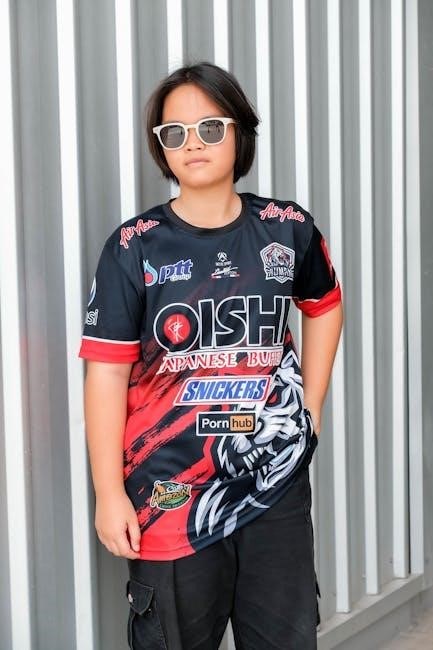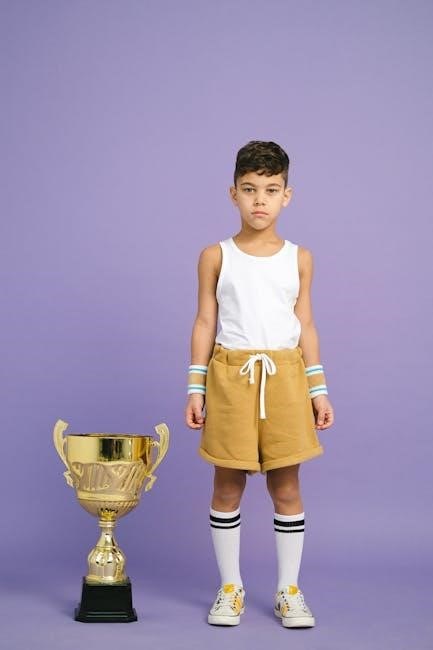Logo placement on polo shirts is crucial for brand visibility and professional appeal․ The left chest remains the most popular choice, offering a clean, visible, and balanced look that aligns with brand identity․ Understanding proper placement ensures your logo stands out while maintaining aesthetic harmony․
Popular Logo Placement Options
Popular logo placements on polo shirts include the left chest, right chest, center chest, and sleeves․ Each offers unique visibility and style, catering to different brand preferences and designs․
Left Chest Placement
The left chest placement is the most popular choice for polo shirt logos, offering a clean, professional look․ It provides high visibility while maintaining a balanced aesthetic․ Typically placed 7-9 inches from the shoulder and 4-6 inches below the collar, this position ensures the logo is easily noticeable without overwhelming the design․ It’s ideal for corporate and sports brands, as it aligns with the natural line of sight․ The standard size for left chest logos is 3-4 inches wide, making it suitable for both embroidery and printing․ This placement is favored for its subtlety and effectiveness in conveying brand identity across various industries․
Right Chest Placement
Right chest placement is a popular alternative to the left chest, offering a bold and modern look․ It’s commonly used by sports brands like Adidas and Under Armour for activewear․ Positioned 7-9 inches from the shoulder and 4-6 inches below the collar, it provides similar visibility to the left chest but with a slightly different aesthetic․ This placement is ideal for brands seeking a less traditional look while maintaining professionalism․ The logo size typically ranges from 3-4 inches wide, ensuring it remains proportionate to the garment․ Right chest placement is favored for its balance and contemporary appeal, making it a great choice for sports and lifestyle brands․
Center Chest Placement
Center chest placement is less common but offers a striking, central location for logos․ It’s ideal for larger designs or brands seeking maximum visibility․ Typically, logos are positioned 10-12 inches wide, spanning the chest area evenly․ This placement ensures the logo is immediately noticeable, making it perfect for bold brand statements․ However, it may not be as versatile as left or right chest placements, as it can overwhelm smaller frames or delicate designs․ Center chest placement is often used for promotional items or specific campaigns where a strong visual impact is desired․ It’s a great choice for brands looking to make a statement while maintaining a professional appearance;
Sleeve Placement
Sleeve placement offers a modern and subtle way to display logos, often used for secondary branding or complementary designs․ Typically positioned on the upper arm area, 4-6 inches below the shoulder seam, this placement is ideal for smaller logos or text․ It allows for a balanced look without overwhelming the garment․ Sleeve logos are popular in sports and activewear, where brands like Adidas and Under Armour frequently use this space․ The placement works well for sponsor logos or additional branding elements, ensuring visibility without distracting from the main design․ It’s a versatile option for creating a cohesive brand identity across team uniforms or promotional apparel․

Factors Influencing Logo Placement
Logo placement on polo shirts is influenced by brand identity, logo size, fabric type, target audience, and purpose․ These elements ensure visibility and complement the shirt’s design․
Brand Identity and Aesthetics
Brand identity and aesthetics play a significant role in determining logo placement on polo shirts․ The left chest area is often preferred as it aligns with brand visibility and professionalism, creating a balanced look; This placement ensures the logo remains prominent without overwhelming the garment․ Aesthetics are further influenced by the logo’s size, shape, and color, which must complement the shirt’s design․ Companies prioritize this placement to maintain a cohesive brand image, ensuring their logo is easily recognizable while preserving the shirt’s clean appearance․ Proper alignment and proportion are key to achieving a visually appealing result that aligns with the brand’s overall identity and style․
Logo Size and Shape
Logo size and shape are critical considerations for polo shirt placement․ A logo that is too large can overwhelm the garment, while one too small may lack visibility․ Typically, logos range from 3 to 4 inches in width for left or right chest placements, ensuring they are easily noticeable without dominating the design․ The shape of the logo should complement the shirt’s layout, with circular or square logos often working well on the chest․ Proper sizing and shaping ensure the logo is both aesthetic and functional, enhancing brand recognition while maintaining the shirt’s overall appeal and professionalism․
Fabric Type and Quality
Fabric type and quality significantly influence logo placement on polo shirts․ Thicker fabrics like piqué or jersey knit are ideal for embroidery, as they provide a stable surface for intricate designs․ Softer or thinner fabrics may require additional stabilizing materials to prevent distortion․ High-quality fabrics ensure logos remain crisp and vibrant, maintaining professional appeal․ The weave and texture of the fabric also affect how embroidery or printing adheres, with tighter weaves generally yielding better results․ Choosing the right fabric ensures durability and visibility of the logo, enhancing both aesthetic and functional aspects of the shirt;
Target Audience and Purpose
Logo placement on polo shirts is heavily influenced by the target audience and purpose․ For corporate or formal events, logos are often placed on the left chest to maintain a professional and polished look․ In contrast, sports teams or activewear brands may prioritize visibility during movement, opting for larger logos on the sleeve or center chest․ The purpose of the shirt, whether for branding, promotions, or team uniforms, also dictates placement․ Understanding the audience ensures the logo resonates effectively, balancing aesthetics with functionality․ Aligning placement with the shirt’s intended use enhances brand visibility and appeal, making it a critical consideration in the design process․

Industry-Specific Logo Placement Trends
Industry-specific trends influence logo placement․ Corporate brands often opt for left chest logos, while sports brands like Adidas prefer the right chest․ Fashion brands may use larger designs on the back for bold statements․
Corporate and Workwear
In corporate settings, the left chest is the most popular placement for logos on polo shirts, ensuring a professional and visible brand presence․ This placement is ideal for workwear, as it maintains a clean, streamlined look while allowing for easy recognition of the company logo․ Many companies opt for embroidery, as it offers durability and a polished appearance․ The logo is typically positioned 7․5 to 9 inches from the left shoulder seam and 4 to 6 inches below the collar, aligning with industry standards․ This approach ensures consistency and aligns with the brand’s identity, making it a practical choice for uniforms and promotional apparel․
Sports and Activewear
In the sports and activewear sector, logo placement on polo shirts often prioritizes visibility and dynamic appeal․ Brands like Adidas and Under Armour frequently place their logos on the right chest or sleeve, creating a bold, modern look that stands out during physical activities․ This placement ensures the logo remains visible even when the wearer is in motion․ For activewear, the design often balances functionality with aesthetics, avoiding clutter while maintaining brand prominence․ The logos are typically embroidered or printed in contrasting colors to enhance visibility․ This approach aligns with the energetic and performance-oriented nature of sports apparel, making it a popular choice for athletic brands․
Fashion and Lifestyle Brands
Fashion and lifestyle brands often use polo shirt logo placement as a key element of their brand storytelling․ While some opt for the classic left chest placement, others experiment with unique positions like the right chest, sleeve, or even the back to create a distinctive look․ These placements are chosen to align with the brand’s aesthetic and target audience, ensuring the logo becomes a subtle yet impactful part of the design․ For lifestyle brands, the logo’s visibility and style are crucial, as it reflects the brand’s identity and appeals to fashion-conscious consumers․ This strategic approach ensures the logo complements the overall design while maintaining brand prominence․

Best Practices for Logo Placement
Ensure logos are proportionate to the shirt size, aligning them centrally on the chest for a balanced look․ Measure carefully to maintain visibility and brand recognition․
Measuring and Aligning Logos
Accurate measuring and alignment are essential for professional logo placement․ Start by measuring from the shoulder seam, placing the logo 7․5 to 9 inches from the left seam and 4 to 6 inches below the collar․ Use a placement chart or template to ensure symmetry․ Fold the shirt to find the center point for smaller logos, ensuring they are level and visually balanced․ For larger logos, align the bottom edge with the chest pocket or slightly above․ Double-check alignment before embroidering to avoid misplacement․ Proper measurement ensures your logo stands out clearly while maintaining a polished, professional appearance․
Balancing Multiple Logos
Balancing multiple logos on a polo shirt requires careful planning to avoid clutter․ Start by designating a primary logo, often on the left chest, and secondary logos on the right chest or sleeve․ Ensure spacing between logos is consistent, typically 4–6 inches apart, to maintain a clean appearance․ For three logos, consider placing two on the chest and one on the sleeve, or one on the chest and two on the sleeves․ Avoid overcrowding by keeping logos proportional in size․ Symmetry is key; align logos evenly and mirror their placement to create visual harmony․ This approach ensures your design remains professional and visually appealing․
Choosing Between Embroidery and Printing
When deciding between embroidery and printing for polo shirt logos, consider durability, cost, and design complexity․ Embroidery is ideal for intricate designs and offers a premium, long-lasting finish, making it perfect for professional branding․ Printing is more cost-effective and suitable for detailed or vibrant logos․ For small, simple designs, embroidery is recommended, while larger, colorful designs may benefit from printing․ Placement also plays a role; embroidery works well on chest areas, while printing can cover larger spaces like the back․ Choose embroidery for a sophisticated look and printing for bold, eye-catching designs, ensuring your brand identity shines through the chosen method․
Tools and Resources for Perfect Placement
Utilize logo placement templates and design software to ensure accurate and visually appealing logo positioning on polo shirts, achieving a professional look easily․
Logo Placement Templates
Logo placement templates are essential tools for achieving precise and professional logo positioning on polo shirts․ These templates provide standard measurements and common placement options, ensuring consistency and accuracy․ Many templates include guidelines for popular positions like the left chest, right chest, and sleeves, offering a visual reference for designers․ They often feature grid lines and measurement markers to help align logos perfectly․ Additionally, templates may include design options for different logo sizes and shapes, making it easier to choose the best fit for your brand․ Suppliers and design software frequently offer customizable templates tailored for polo shirts, ensuring a polished and professional finish․
Design Software for Visualization
Design software plays a crucial role in visualizing logo placement on polo shirts․ Tools like Adobe Illustrator and CorelDRAW allow users to create digital mockups, ensuring precise logo positioning․ Online platforms offer templates specifically for polo shirts, enabling brands to preview designs before production․ These tools provide features such as adjustable sizing, alignment guides, and fabric texture simulations․ They also support multiple logo formats, making it easy to test different placements․ By using design software, brands can experiment with various layouts and ensure their logos appear professional and well-integrated․ This step saves time and resources, helping to achieve the desired aesthetic effortlessly․

Common Mistakes to Avoid
When placing logos on polo shirts, several common mistakes can undermine the final result․ One of the most frequent errors is improper logo alignment, which can make the design appear unprofessional․ Additionally, logos that are too large or too small for the shirt can disrupt the aesthetic balance․ Overcrowding the shirt with multiple logos is another mistake, as it can distract from the primary branding․ Neglecting to consider fabric type and texture can also lead to poor print quality or embroidery visibility․ Finally, failing to test the design on an actual shirt before bulk production can result in unexpected issues․ Avoiding these pitfalls ensures a polished and professional look․
Mastering logo placement on polo shirts is essential for creating a professional and visually appealing brand representation․ By understanding popular placements, considering factors like fabric type and brand identity, and avoiding common mistakes, you can ensure your logo stands out․ Leveraging tools and resources, such as templates and design software, helps achieve precise and polished results․ Whether for corporate wear, sports, or fashion, proper logo placement enhances both functionality and style․ Applying these insights will help you make informed decisions, ensuring your brand’s logo is showcased effectively on polo shirts; A well-placed logo not only elevates your brand’s image but also leaves a lasting impression․
Logo placement on polo shirts is a critical aspect of brand representation, influencing both visibility and aesthetics․ The left chest area is a favored choice for many brands, offering a balanced and professional appearance․ This placement ensures logos are prominently displayed without being overpowering․ For those seeking a bolder look, the center chest provides a more prominent display, while sleeve placements offer a subtle yet stylish alternative․ Embroidery is often preferred for its durability and polished finish, making it ideal for creating long-lasting brand impressions․ Proper measurement and alignment are essential to achieve a cohesive look across all garments․ This guide will explore these considerations, providing insights to help you make informed decisions about your logo placement․

Popular Placements
The left chest is the most popular choice for polo shirt logos, offering a clean, professional look․ Right chest placement provides a bold statement, while center chest placement ensures maximum visibility․ Sleeve placement offers a subtle yet stylish alternative, ideal for modern designs․
Left Chest
The left chest placement is the most popular choice for polo shirt logos, offering high visibility and a professional appearance․ It is commonly used by companies for workwear, as it aligns with brand identity and maintains a balanced look․ The logo remains visible without being overly distracting, making it ideal for both casual and formal settings․ This placement works well for embroidery and printing, ensuring clarity and durability․ Typically, logos are positioned 3-4 inches below the collar, centered on the chest․ This location complements the shirt’s design without overwhelming it, making it a timeless choice for brands seeking a classic, polished look․
Right Chest
The right chest placement is a popular alternative to the left chest, offering a similar professional and balanced look․ Brands like Adidas and Under Armour often use this placement for activewear, creating a modern and sleek appearance․ It provides high visibility while maintaining a clean design, making it ideal for logos that need to stand out without being overly prominent․ The right chest placement is particularly effective for athletic apparel, as it complements the shirt’s structure and ensures the logo remains noticeable during movement․ This position is versatile, suitable for both embroidery and printing, and works well for a variety of logo sizes and shapes․
Center Chest
Center chest placement is a bold and eye-catching option, positioning the logo directly in the middle of the shirt․ This placement is less common but can be highly effective for creating a striking visual impact․ It works best with smaller to medium-sized logos that are symmetrically designed, as asymmetrical logos may appear off-balance․ The center chest placement is ideal for brands aiming to make a strong statement, as it draws immediate attention․ However, it may not be suitable for all designs, especially larger or intricate logos, which could overwhelm the shirt․ This placement is often used for fashion-forward brands or specific promotional campaigns․
Sleeve
Sleeve placement is a unique and modern way to showcase logos on polo shirts, offering a subtle yet stylish alternative to chest placements․ This option is particularly popular for sports and activewear brands, as it provides visibility during movement without overwhelming the design․ Logos on the sleeve are often smaller and more discreet, making them ideal for brands seeking a understated presence․ The sleeve placement works best with simple, iconic designs that don’t require intricate details․ It also allows for creative freedom, as logos can be positioned vertically or horizontally depending on the desired aesthetic․ This placement balances brand visibility with wearer comfort, making it a practical choice for dynamic environments․
Factors Influencing
Several factors influence the optimal placement of logos on polo shirts, ensuring both aesthetic appeal and functionality․ Brand identity plays a crucial role, as logos should align with the company’s image and messaging․ The size and shape of the logo must complement the shirt’s design, avoiding overcrowding or distortion․ Fabric type and quality also matter, as certain materials may require specific printing or embroidery techniques․ Additionally, the target audience and purpose of the shirt, whether for corporate events, sports, or casual wear, dictate placement preferences․ Balancing these elements ensures the logo is visible, professional, and enhances the overall design of the polo shirt․




About the author